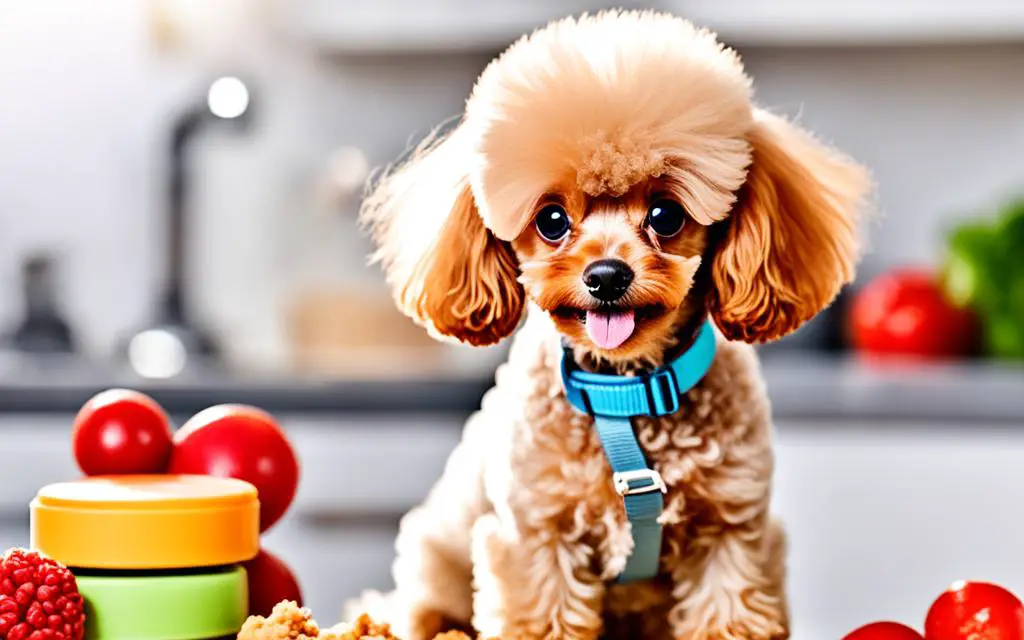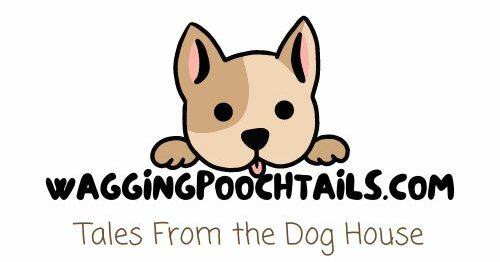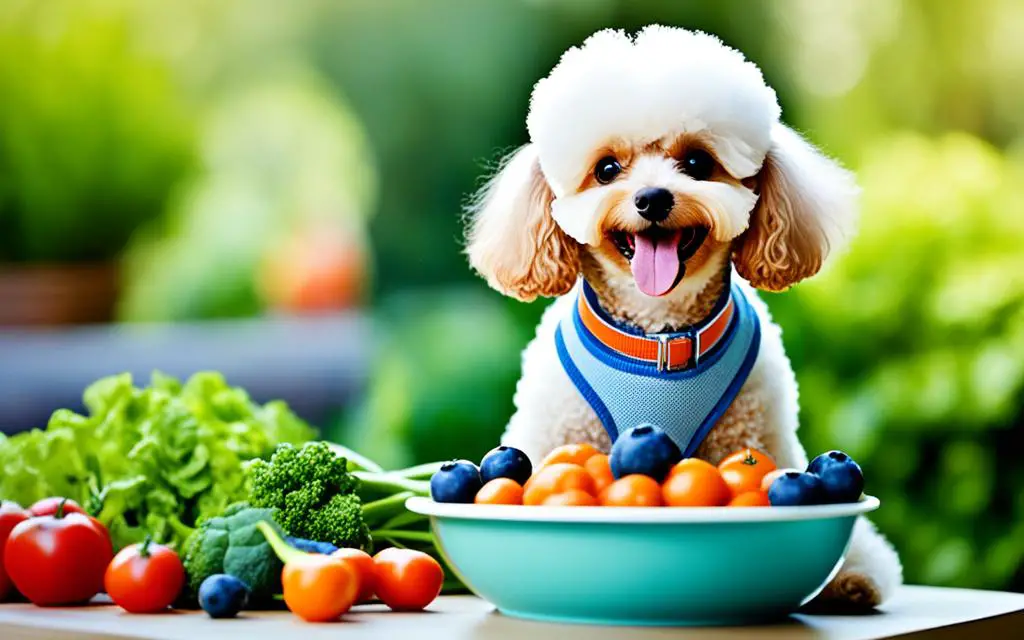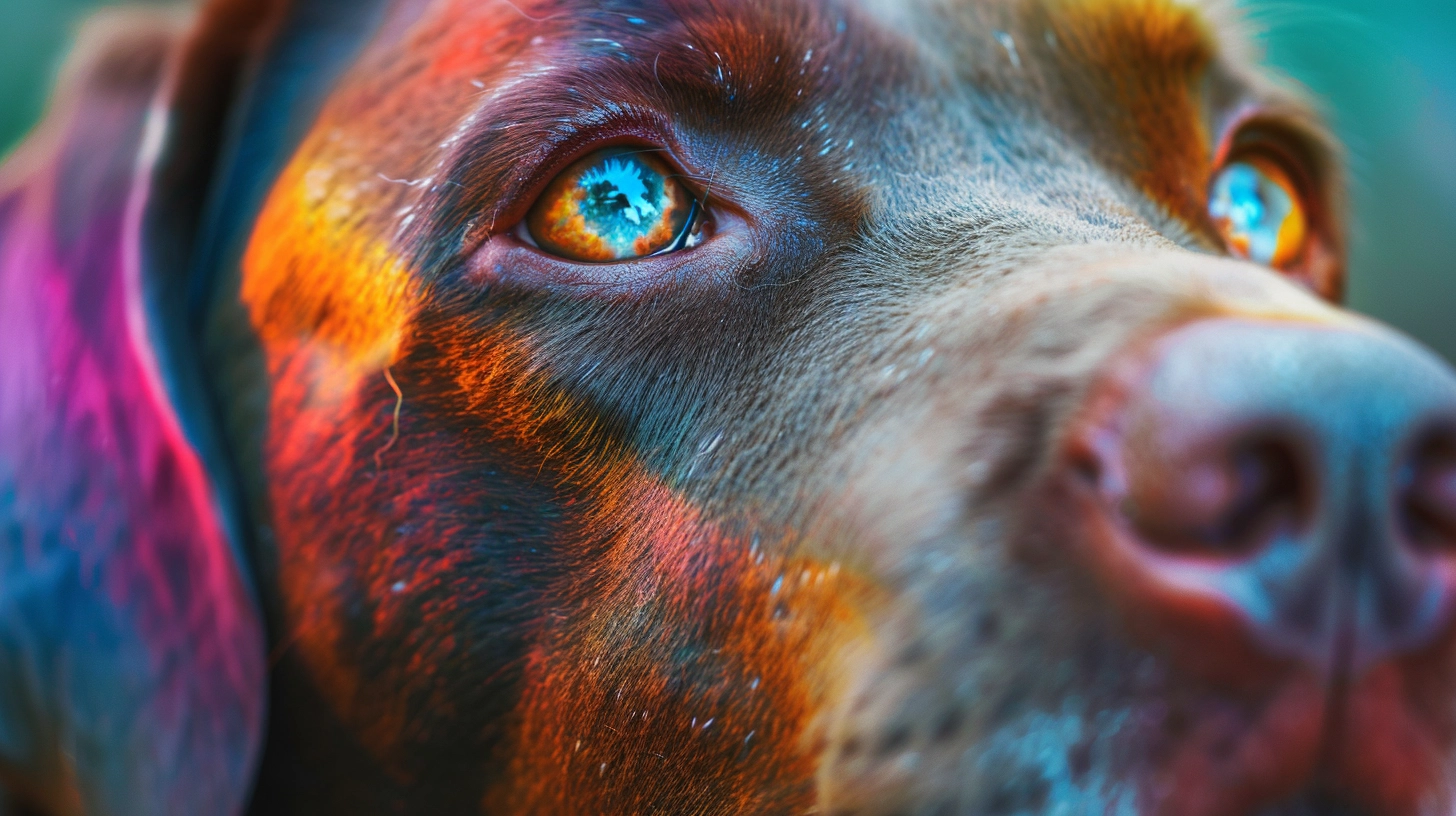Feeding your Toy Poodle is about more than just food. It’s about keeping them healthy and happy. A balanced diet is key. But, finding the right food among many options can be tough.
Let’s talk about Bella, a lively Toy Poodle. She faced digestive problems and her coat was dull. Even though she was playful, she wasn’t at her best.
Bella’s owner, Sarah, wanted to make Bella feel better. She looked into what Toy Poodles need to eat. She got advice from experts and checked out food options.
Sarah then switched Bella to a homemade diet. This included fresh, healthy meals with the right mix of protein, fats, and vitamins. Bella’s coat became shiny and she had more energy.
Sarah learned how vital the right feeding plan is for Toy Poodles. She set a feeding schedule that fit both Bella and her own busy life.
Day by day, Bella’s health got better. Her digestion improved and she was more energetic. Sarah’s effort in finding the best diet for Bella was a success.
Sarah now wants to share her tips with other Toy Poodle owners. We’ll cover how to feed your Toy Poodle right. This includes when to feed them, and choosing between wet and dry food. We’ll look into grain vs. grain-free diets and the best food choices.
Key Takeaways:
- Create a well-balanced diet for your Toy Poodle to ensure their overall health and well-being.
- Consider homemade meals to provide fresh and nutritious food tailored to your Toy Poodle’s needs.
- Develop a feeding schedule and meal plan that works for your Toy Poodle and your lifestyle.
- Understand the pros and cons of wet versus dry food for Toy Poodles.
- Explore the debate surrounding grain versus grain-free diets and consult with your veterinarian to determine the best option for your Toy Poodle.
New Puppies – The Importance of Gradually Switching Foods
Getting a new Toy Poodle puppy is thrilling, but adjusting their diet carefully is key. Talk with the breeder or shelter about the puppy’s current food before bringing them home. A slow change to a new diet over three weeks is best to avoid stomach issues and keep your puppy healthy.
In the first week, mix their old food with 25% of the new one. This gentle start helps their belly get used to new food. Watch how they react to ensure they’re okay. Slowly increase the new food amount each week until it’s all they eat.
Gradually changing your puppy’s diet prevents stomach problems and lets their belly adjust well. Sudden food switches can cause diarrhea and vomiting. A slow transition makes for a smoother switch, reducing the risk of upset and keeping your puppy both happy and healthy.
Puppy Feeding Schedule
A steady feeding schedule is vital for your puppy’s health and growth. With their small stomachs and high energy needs, puppies do best with regular, balanced meals.
Here is a basic feeding schedule for your puppy:
| Age | Number of Meals per Day |
|---|---|
| 8-12 weeks | 4 meals |
| 3-6 months | 3 meals |
| 6-12 months | 2 meals |
Keep in mind, your puppy’s feeding needs might be different. Always check with your vet for advice tailored to your puppy.
Gradually transitioning to a new food over three weeks is recommended to avoid digestive problems and ensure your puppy’s health.
By taking your time with food changes and setting a regular feeding schedule, you’re helping your Toy Poodle puppy grow up strong and happy.
How Often to Feed a Poodle
Giving your Poodle the right food in the right amounts is key to their health. Feedings change with their age and size. Here is what you need to know to feed your Toy Poodle well.
Feeding Schedule for Puppies
Puppies under 3 months need to eat often to grow strong. They should have access to food all the time. This way, they can eat little but often during the day. Make sure the food is high-quality and made for puppies.
Transition to Regular Meals
At 3 months, start giving your Toy Poodle set meals. This creates a regular eating habit and stops them from eating too much. They should have three meals a day. Serve their food at the same times each day to watch how much they eat. Don’t forget to change how much food you give as they grow.
Feeding Schedule for Adult Toy Poodles
Adult Toy Poodles need a feeding schedule that fits their lifestyle. They usually eat two to three meals daily. How often they eat depends on their size, how active they are, and their metabolism. Some might like two big meals, others three smaller ones. Watch their weight and change food amounts to avoid over or underfeeding.
Keeping a regular feeding schedule is very important. It keeps their digestion healthy and their metabolism even. Always have fresh water available for them to drink with their meals.
| Age | Feeding Schedule |
|---|---|
| Under 3 months | Free-fed – food available at all times |
| 3-6 months | Three meals a day |
| 6 months and older | Two to three meals a day |
How Much to Feed a Poodle
The food a Toy Poodle needs depends on its age, weight, and activity. Puppies eat more because they are growing. To feed your Toy Poodle right, consider what they need.
Toy Poodle Serving Size: Usually, a Toy Poodle needs 1 ounce of food per pound of their weight. So, a 10-pound Toy Poodle should eat about 10 ounces each day. Remember, this number can change based on different factors.
Toy Poodle Calorie Requirements: How many calories a Poodle needs changes with age, activity, and how fast their body works. Puppies need lots of calories. But, adult dogs need enough to stay at a healthy weight. Your vet can help figure out the best calorie intake.
Toy Poodle Daily Food Intake: Besides how much and how many calories, spread out your Toy Poodle’s meals. It helps them not eat too much at once, digest better, and keep their energy even. Adult Toy Poodles do well on 2-3 meals a day. Puppies might need to have food available all the time until they’re 3 months old.
These tips are just the start. Each Toy Poodle is unique. Think about how active they are, their health, and their size when feeding them. Always talk to your vet for advice that fits your Toy Poodle.
Example Toy Poodle Feeding Guide
| Weight | Serving Size (ounces) | Calories (per day) |
|---|---|---|
| 5 pounds | 5 ounces | 300-400 |
| 10 pounds | 10 ounces | 500-700 |
| 15 pounds | 15 ounces | 800-1000 |
| 20 pounds | 20 ounces | 1000-1200 |
Wet vs Dry Food for Poodles
Deciding on the right food for your Toy Poodle means choosing between wet or dry meals. Many Poodles like wet food more because it’s tastier and softer. But, dry food has benefits worth thinking about.
Benefits of Wet Food for Poodles
- Palatability: For picky eaters or dogs with teeth problems, wet food is often better because it’s soft and tasty.
- Hydration: Wet food helps keep your Poodle hydrated with its high moisture, very helpful if they don’t drink much water.
- Dietary Variety: Wet food lets you give your Poodle many flavors and proteins, offering them a varied diet.
Benefits of Dry Food for Poodles
- Dental Health: Chewing dry food can help keep teeth clean by reducing plaque and tartar.
- Digestive Health: Dry food is usually high in fiber which helps with digestion and keeping bowel movements regular.
- Convenience: Dry food is easier to store and clean up than wet food.
Feeding only wet food might cause loose stools. It’s key to pick high-quality food, wet or dry, that fits your Poodle’s diet needs.
Choosing the Right Food for Your Poodle
“Choosing the best food for your Poodle can be hard. Look at their likes, age, and health. Talking to your vet can help pick the right diet for your pet.”
Think about your Poodle’s teeth, belly, and likes when choosing food. Some might need the dental benefits of dry food. Others might do better with wet food’s taste and moisture. The best choice depends on your Poodle’s needs and preferences.
Keeping your Toy Poodle healthy means offering them a balanced, top-quality diet. Talk to your vet to make sure you’re giving the best food, whether it’s wet, dry, or both.
Grain vs Grain-Free Diet for Poodles
Choosing the right diet for your Toy Poodle often leads to a debate: grain or grain-free? Both choices have their advantages and disadvantages. It’s crucial to look at your dog’s needs and ask your vet for advice.
Toy Poodles may be allergic to grains. This can cause itching, stomach issues, or skin problems. In these cases, vets often suggest a grain-free diet. It can make your Poodle feel better overall.
Yet, not all dogs need to avoid grains. Grains supply important nutrients and fiber. Foods like brown rice or oats are good for your Poodle. They provide carbs and energy.
Recent research connects grain-free diets to a higher chance of dilated cardiomyopathy (DCM) in some dogs, including Poodles. DCM is a severe heart condition that can lead to heart failure if untreated. The exact reason for this link is still being studied. But, it shows the importance of being careful with grain-free diets.
When deciding on a diet for your Poodle, consider their health needs, allergies, and heart disease risks. Your vet can help you make the best choice for your Poodle.
| Grain Diet | Grain-Free Diet |
|---|---|
| Contains essential nutrients and fiber | Eliminates potential allergens |
| Provides a source of carbohydrates and energy | May reduce itching and skin problems in dogs with grain allergies |
| – | May increase the risk of dilated cardiomyopathy (DCM) |
Choosing the Right Food for Your Poodle
Finding the right food for your Toy Poodle requires considering a few important factors. Their special nutritional needs, including the right mix of proteins and fats, are crucial. You should focus on high-quality dog food brands. These brands should provide balanced nutrition suited to small breeds like the Poodle.
Keep these important points in mind when picking the perfect food for your Poodle:
- Protein Content: Poodles do well on a diet with moderate to high protein. Seek out dog foods where real meat, like chicken, turkey, or fish, is the first listed ingredient.
- Fat Content: Healthy fats are crucial for a Poodle’s diet as they provide energy and aid in body functions. Choose dog foods that include quality fat sources, such as chicken fat or fish oil.
- Size-appropriate kibble: Since Toy Poodles have small mouths, it’s important to pick a food with smaller kibble. This makes it easier for them to chew their food.
- Age-appropriate options: Puppies and adult Poodles have different dietary needs. Ensure to select a food that’s designed for their specific life stage.
- Vet-approved brands: Consulting your vet for dog food brand recommendations is a wise move. They can offer advice tailored to your Poodle’s unique needs.
Remember: Each Poodle is different, and what works for one might not suit another. Watch your Poodle’s health and preferences closely. If they show any signs of food allergies or digestive troubles, talk to your vet to find the best diet for them.

“Choosing the right food is key for your Poodle’s health and happiness. A nutritious diet helps lay the foundation for a joyful life together.” – Dr. Lisa Anderson, DVM
| Top Recommended Dog Food Brands for Poodles | Key Features |
|---|---|
| 1. Royal Canin Breed Health Nutrition | – Tailored nutrition for Toy Poodles – Supports healthy digestion and coat health |
| 2. Hill’s Science Diet | – Offers a variety of options for different life stages – Contains high-quality ingredients |
| 3. Blue Buffalo Life Protection Formula | – Natural and holistic approach to nutrition – Real meat as the first ingredient |
| 4. Merrick Lil’ Plates Grain-Free | – Grain-free options for sensitive Poodles – High-quality, real meat ingredients |
| 5. Wellness CORE Grain-Free | – Protein-rich formula for active Poodles – Grain-free and balanced nutrition |
While the dog food brands listed above come highly recommended, not every Poodle will like the same brand. Always consider your Poodle’s unique needs and tastes.
Importance of Transitioning Dog Food
Switching your Toy Poodle’s food slowly is important for their stomach. It helps prevent tummy troubles and gets them used to new food easily. Follow these steps to change dog food smoothly:
- Mix a little of the new food with the old. Start with 25% new and 75% old.
- Over 7-10 days, increase the new food and decrease the old. Aim for half-and-half by week’s end.
- Keep increasing the new food’s share. By the end, your Poodle should eat only the new food.
Watch your Poodle closely during this time. Check their stools, energy, and overall health. If they seem upset or uncomfortable, slow down the switch or talk to a vet.
Benefits of a Gradual Transition for Toy Poodles
A slow switch helps your Toy Poodle’s stomach adjust without issues. It eases them into the new food, so their body can get used to it.
Gradually changing food is like slowly introducing a new pal to your Poodle’s belly. It helps them adjust without shock.
Also, a slow switch lets you spot any bad reactions to the new food. By taking it slow, you can figure out what’s causing any problems more easily.
Why Switching Food for Toy Poodles Requires Care
Toy Poodles are sensitive, both in body and mind. A quick diet change can upset their routine and cause stomach or eating issues. A gradual food switch helps them adjust better and meets their nutrition needs.
Table: Common signs of improper dog food transitioning
| Signs of Improper Food Transition | Possible Consequences |
|---|---|
| Upset Stomach | Diarrhea, vomiting, and discomfort |
| Refusal to Eat | Loss of appetite and nutritional deficiencies |
| Inconsistent Stools | Soft or runny stools, difficulty in house-training |
| Weight Fluctuations | Unhealthy weight gain or weight loss |
By taking it slow, you can make sure your Toy Poodle gets used to their new food well. This keeps them healthy and happy.
Signs Your Poodle Needs a Food Change
If your Poodle starts acting differently, has coat or skin issues, or often gets sick to their stomach, it might mean their food isn’t right for them. Watch your Poodle closely for these signs. Consulting your vet is key if you notice these signs.
Behavioral changes
Poodles can act out when their food doesn’t suit them. This could look like being really tired, moving a lot, itching more, or not wanting to eat. If your Poodle is acting oddly, thinking about a food switch might be a good idea.
Coat or skin problems
Poodles boast a fancy coat that needs the right nutrients to stay healthy and shiny. Problems like shedding a lot, skin being dry or flaky, a dull coat, or constant skin troubles show their diet may lack important nutrients. Changing their food could boost their coat and skin health.
Persistent digestive issues
Does your Poodle often have upset stomach issues like diarrhea, throwing up, or gas? This could point to problems with their food. This might mean they’re not okay with something they’re eating. An alternate diet might help ease their stomach woes.
Every Poodle is different, so what helps one might not help another. Keep an eye on your Poodle’s mood, skin, and tummy health to spot food issues. Your vet can offer insights and advice to choose the right food for your pet.
| Signs Your Poodle Needs a Food Change |
|---|
| Behavioral changes |
| Coat or skin problems |
| Persistent digestive issues |
Keeping your Poodle happy and healthy is crucial. Watch their behavior, coat, and digestive system for signs they may need new food. A vet can guide you to make the best choice for your furry friend.

Transitioning From Puppy to Adult Food
Your Toy Poodle’s nutritional needs change as they grow. Transitioning from puppy food to adult food is crucial for their development. A gradual process helps avoid digestive problems and ensures a smooth change.
When to switch Toy Poodles to adult food depends on their size, breed, and growth rate. They usually transition between 9 to 12 months. But, it’s important to check with a vet to find the best time for your dog.
Moving to adult food should take 7-10 days. This slow shift helps your Poodle’s stomach get used to the new food. Here’s how to do it right:
- Mix a little adult food with their puppy food. Start with 75% puppy food and 25% adult food.
- Watch how your Poodle reacts to the mix. If they’re okay, keep this mix for another 2-3 days.
- Slowly increase the adult food amount. Aim for a 50/50 mix of puppy and adult food.
- Keep adjusting the mix until your Poodle eats only adult food.
Watch your Poodle’s behavior and stool during the change. If they show any discomfort or loose stool, slow down the switch. Give their stomach more time to adapt.
A smooth transition to adult food sets up your Poodle for a healthy life. Follow these steps and work with your vet. This way, you’re giving your dog the best start as an adult.
| Benefits of Transitioning Gradually: |
|---|
| Prevents digestive upset and discomfort |
| Allows the digestive system to adjust to new food |
| Reduces the risk of food aversion |
Conclusion
Making sure your Toy Poodle eats well is key to their health and happiness. By using these feeding tips for Toy Poodles, you help your pet be their best.
To start, learn the right feeding rules for Toy Poodles. Know when and how much to feed them. It’s all about giving them the right amount of good food.
Finding the best food is crucial. Choose top-notch dog food that’s rich in proteins, fats, and vitamins. Pick wet or dry food that suits your Poodle’s needs.
Change your Poodle’s food slowly to avoid upset stomachs. Mix in the new food while phasing out the old over one to two weeks. Watch how your dog does with the change.
Always talk to your vet about your Toy Poodle’s diet. They can offer advice tailored to your dog’s health. Following these tips on optimizing your Toy Poodle’s diet ensures a joyful, healthy life for your pet.





Leave a Reply